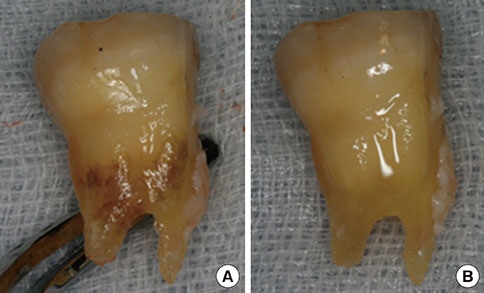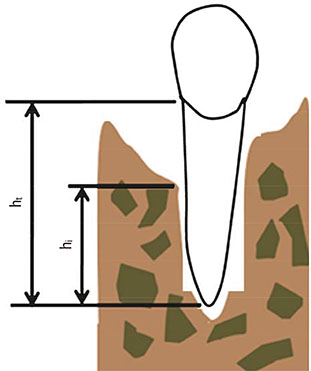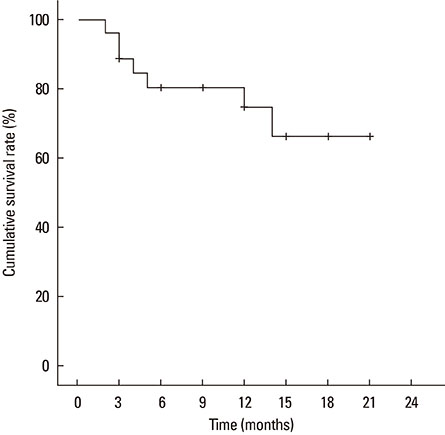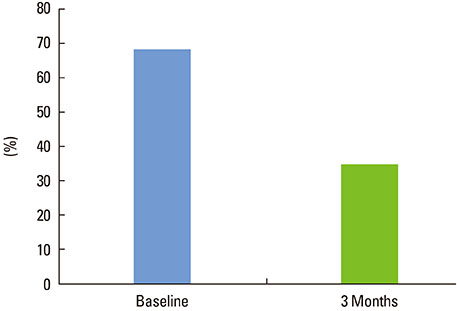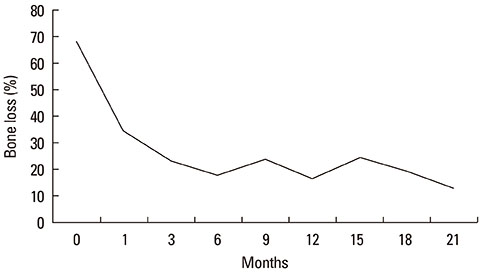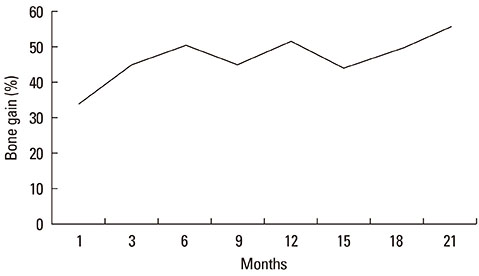J Periodontal Implant Sci.
2014 Feb;44(1):13-19. 10.5051/jpis.2014.44.1.13.
Delayed intentional replantation of periodontally hopeless teeth: a retrospective study
- Affiliations
-
- 1Department of Periodontology, Research Institute for Periodontal Regeneration, Yonsei University College of Dentistry, Seoul, Korea. shchoi726@yuhs.ac
- 2Microscope Center, Department of Conservative Dentistry and Oral Science Research Center, Yonsei University College of Dentistry, Seoul, Korea.
- KMID: 1845874
- DOI: http://doi.org/10.5051/jpis.2014.44.1.13
Abstract
- PURPOSE
The purpose of this study was to retrospectively evaluate the survival of periodontally hopeless teeth that were intentionally extracted and replanted after a delay and to compare the radiographic characteristics of the survival group with those of the failure group.
METHODS
The clinical and radiographic data from patients who underwent delayed intentional replantation between March 2000 and July 2010 were reviewed. Twenty-seven periodontally hopeless teeth were extracted and preserved in medium supplemented with antibiotics for 10-14 days. The teeth were then repositioned in the partially healed extraction socket and followed for 3 to 21 months. The radiographic parameters were analyzed using a paired t test and the cumulative survival rate was analyzed using Kaplan-Meier analysis.
RESULTS
Seven replanted teeth failed and the overall cumulative survival rate was 66.4%. In the survival group, the amount of bone loss was reduced from 68.45% to 34.66% three months after replantation. There was radiologic and clinical evidence of ankylosis with 5 teeth. However, no root resorption was found throughout the follow-up period. In the failure group, bone formation occurred from the bottom of the socket. However, a remarkable radiolucent line along the root of a replanted tooth existed. The line lengthened and thickened as time passed. Finally, in each case of failure, the tooth was extracted due to signs of inflammation and increased mobility.
CONCLUSIONS
Delayed intentional replantation has many advantages compared to immediate intentional replantation and could serve as an alternative treatment for periodontally involved hopeless teeth. However, techniques for maintaining the vitality of periodontal structures on the tooth surface should be developed for improved and predictable results.
Keyword
MeSH Terms
Figure
Cited by 2 articles
-
Effect of fibroblast growth factor on injured periodontal ligament and cementum after tooth replantation in dogs
Sang-Joun Yu, Jung-Seok Lee, Ui-Won Jung, Joo-Cheol Park, Byung-Ock Kim, Seong-Ho Choi
J Periodontal Implant Sci. 2015;45(3):111-119. doi: 10.5051/jpis.2015.45.3.111.Evaluation of the periodontal and pulpal healing of replanted rat molars with doxycycline root conditioning
Ok Hyung Nam, Kyounga Cheon, Mi Sun Kim, Hyo-Seol Lee, Sung Chul Choi
J Periodontal Implant Sci. 2019;49(3):148-157. doi: 10.5051/jpis.2019.49.3.148.
Reference
-
1. Machtei EE, Hausmann E, Dunford R, Grossi S, Ho A, Davis G, et al. Longitudinal study of predictive factors for periodontal disease and tooth loss. J Clin Periodontol. 1999; 26:374–380.
Article2. Nieri M, Muzzi L, Cattabriga M, Rotundo R, Cairo F, Pini Prato GP. The prognostic value of several periodontal factors measured as radiographic bone level variation: a 10-year retrospective multilevel analysis of treated and maintained periodontal patients. J Periodontol. 2002; 73:1485–1493.
Article3. Wang J, Jiang Y, Chen W, Zhu C, Liang J. Bacterial flora and extraradicular biofilm associated with the apical segment of teeth with post-treatment apical periodontitis. J Endod. 2012; 38:954–959.
Article4. Siqueira JF Jr. Aetiology of root canal treatment failure: why well-treated teeth can fail. Int Endod J. 2001; 34:1–10.
Article5. Ferencz JL. Splinting. Dent Clin North Am. 1987; 31:383–393.6. Lu DP. Intentional replantation of periodontally involved and endodontically mistreated tooth. Oral Surg Oral Med Oral Pathol. 1986; 61:508–513.
Article7. Demiralp B, Nohutcu RM, Tepe DI, Eratalay K. Intentional replantation for periodontally involved hopeless teeth. Dent Traumatol. 2003; 19:45–51.
Article8. Miller SC. Textbook of peridontia: oral medicine. 3rd ed. Philadelphia: Blackistone;1950.9. Schulte W, d'Hoedt B, Lukas D, Maunz M, Steppeler M. Periotest for measuring periodontal characteristics: correlation with periodontal bone loss. J Periodontal Res. 1992; 27:184–190.
Article10. Gargiulo AW, Wentz FM, Orbal B. Dimensions and relations of the dentogingival junction in humans. J Periodontol. 1961; 32:261–267.
Article11. Peer M. Intentional replantation: a 'last resort' treatment or a conventional treatment procedure? Nine case reports. Dent Traumatol. 2004; 20:48–55.
Article12. Cardaropoli G, Araujo M, Hayacibara R, Sukekava F, Lindhe J. Healing of extraction sockets and surgically produced - augmented and non-augmented - defects in the alveolar ridge. An experimental study in the dog. J Clin Periodontol. 2005; 32:435–440.
Article13. Cardaropoli G, Araujo M, Lindhe J. Dynamics of bone tissue formation in tooth extraction sites. An experimental study in dogs. J Clin Periodontol. 2003; 30:809–818.14. Kim DJ, Cha JK, Yang C, Cho A, Lee JS, Jung UW, et al. Changes in periodontium after extraction of a periodontally-involved tooth in rats. J Periodontal Implant Sci. 2012; 42:158–165.
Article15. Nasjleti CE, Castelli WA, Blankenship JR. The storage of teeth before reimplantation in monkeys. A histologic study. Oral Surg Oral Med Oral Pathol. 1975; 39:20–29.16. Kum KY, Kwon OT, Spangberg LS, Kim CK, Kim J, Cho MI, et al. Effect of dexamethasone on root resorption after delayed replantation of rat tooth. J Endod. 2003; 29:810–813.
Article17. Lindskog S, Pierce AM, Blomlof L, Hammarstrom L. The role of the necrotic periodontal membrane in cementum resorption and ankylosis. Endod Dent Traumatol. 1985; 1:96–101.
Article18. Mahajan SK, Sidhu SS. Periodontal ligament, extra-oral period and use of fluorides in replantation of teeth. Indian J Med Res. 1982; 75:441–445.19. Baltacioglu E, Tasdemir T, Yuva P, Celik D, Sukuroglu E. Intentional replantation of periodontally hopeless teeth using a combination of enamel matrix derivative and demineralized freeze-dried bone allograft. Int J Periodontics Restorative Dent. 2011; 31:75–81.
- Full Text Links
- Actions
-
Cited
- CITED
-
- Close
- Share
- Similar articles
-
- Treatment of a tooth with severe periodontal involvement using intentional replantation: case report
- Changes in periodontium after extraction of a periodontally-involved tooth in rats
- A comparative study of periodontal conditions around mesially tipped molars by a tipping degree
- A retrospective study of the intentionally replanted mandibular second molars with C-shaped root canal configurations
- Intentional replantation with preapplication of orthodontic force on mandibular second molar

